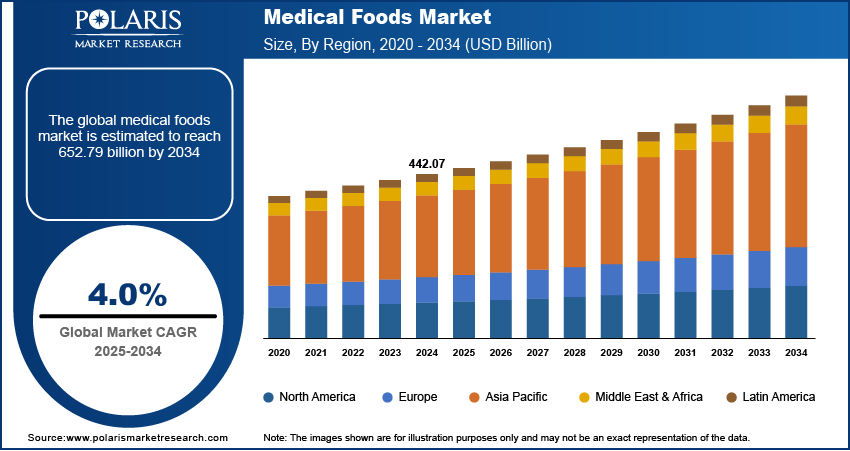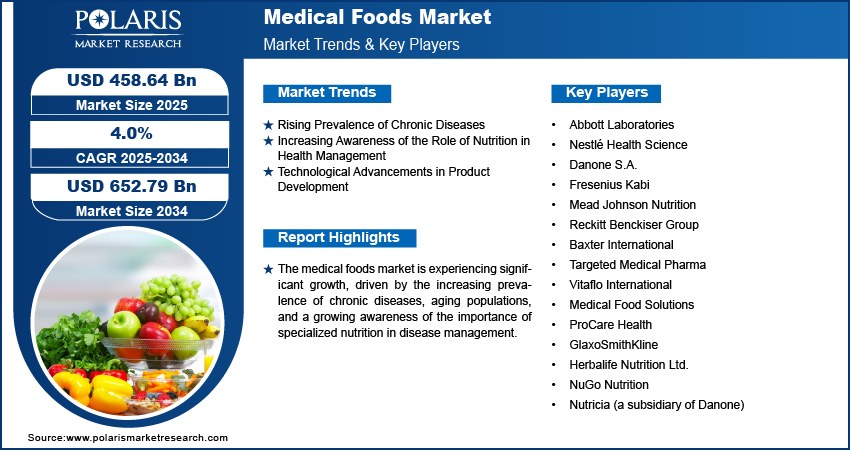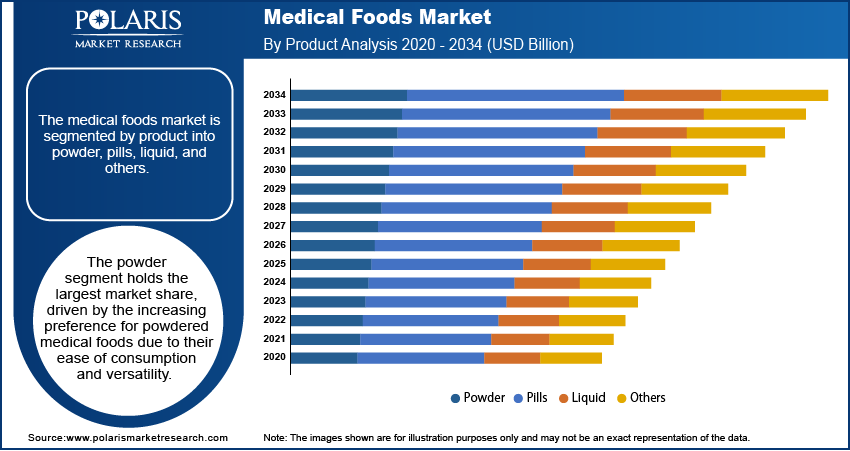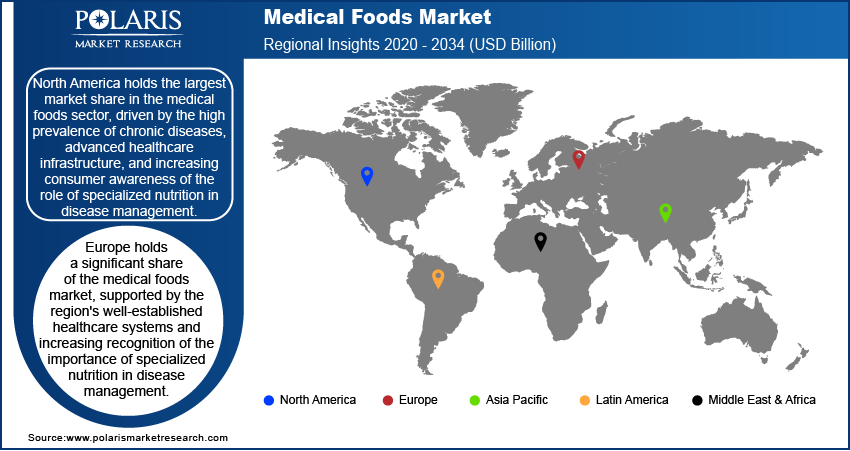
Medical Foods Market Share, Size, Trends, Industry Analysis Report, By Product (Pills, Powder, Liquid, Others); By Route of Administration (Oral, Enteral); By Application; By Region; Segment Forecast, 2024 - 2032
- Published Date:Jan-2024
- Pages: 118
- Format: PDF
- Report ID: PM4064
- Base Year: 2023
- Historical Data: 2019-2022
Report Outlook
The global medical foods market was valued at USD 24.02 billion in 2023 and is expected to grow at a CAGR of 5.1% during the forecast period.
Medical foods are products specially formulated to meet the unique nutritional requirements of individuals with specific medical conditions. They are different from regular foods and should only be consumed under the guidance of a healthcare professional. Medical foods contain various nutrients like vitamins, minerals, and amino acids that provide targeted nutritional support. They are designed to manage specific medical conditions such as metabolic disorders like phenylketonuria (PKU) and neurological conditions such as Alzheimer's disease. The U.S. FDA regulates medical foods, requiring them to meet specific criteria, such as being intended for managing a particular medical condition, supervised by healthcare providers, and tailored to meet unique nutritional requirements.
The research study provides a comprehensive analysis of the industry, assessing the market on the basis of various segments and sub-segments. It sheds light on the competitive landscape and introduces Medical Foods Market key players from the perspective of market share, concentration ratio, etc. The study is a vital resource for understanding the growth drivers, opportunities, and challenges in the industry.
It is a specifically prepared and processed commodity for the restricted or absolute feeding of a patient, utilizing oral consumption or enteral feeding by tube. It is deliberated for the dietary handling of patients who, due to therapeutic or detrimental medical requirements, have restricted or decreased potential to ingest, digest, soak up, or break down regular foodstuffs or specific nutrients or who have other exceptional medically intended nutrient needs, the dietary handling of which cannot be obtained through tempering the standard diet alone.
Recognizing contemporary medical food could augment the gamut of obtainable treatment alternatives for patients. The medical foods market size is expanding as possessing more cure alternatives is usually better. It is particularly significant for those with illnesses that have yet to be concentrated in pharmaceutical firms, such as conditions that are less prevalent and less comprehended by political and business leaders.

To Understand More About this Research: Request a Free Sample Report
- For instance, in March 2022, Lanfam LLC has introduced Proleeva, a medical food recognized by the US FDA, formulated to address amino acid deficiencies in chronic pain and inflammatory disorders such as fibromyalgia, osteoporosis, diabetic neuropathy, and rheumatoid arthritis.
The demand for medical foods has increased due to the growing aging population, changing consumer preferences, and rising awareness of the importance of preventive healthcare. People are now more health-conscious and are looking for foods that can address specific health concerns or provide targeted nutritional benefits. Medical foods offer a personalized approach to nutrition, making them an appealing choice for those who want to manage their health and well-being.
In addition, with the progress made in research and development, medical food products are becoming increasingly effective, which has led to a significant increase in demand. As we continue to innovate and gain a better understanding of the connection between nutrition and our health, the medical foods industry is predicted to continue growing in the upcoming years. This growth will provide new and improved solutions for managing various medical conditions and promoting overall wellness.

Growth Drivers
- Rising Prevalence of Chronic Diseases
The medical foods market is growing due to the increasing prevalence of chronic diseases. Chronic diseases, including diabetes, cardiovascular conditions, obesity, and metabolic disorders, are on the rise globally. These diseases often require long-term management, and nutrition plays a vital role in their treatment and prevention. As healthcare systems worldwide struggle to cope with the growing burden of chronic diseases, medical foods have become an essential tool for healthcare professionals to address patients' specific nutritional needs.
Managing chronic diseases can be challenging and often requires a specialized diet to control symptoms and improve overall quality of life. Medical foods are designed to meet these unique nutritional requirements based on scientific principles. They contain essential nutrients, vitamins, and amino acids that can help manage chronic diseases effectively. With the prevalence of chronic diseases on the rise, the demand for medical foods as a critical component of disease management and prevention strategies is expected to increase.
The COVID-19 pandemic has emphasized the need to manage underlying health conditions as people with pre-existing chronic diseases are at a higher risk of severe outcomes. This has made it clear that nutrition and medical foods play a significant role in supporting immunity and overall well-being. As a result, the prevalence of chronic diseases has increased the demand for medical foods, and their essential role in modern healthcare has been highlighted, contributing to the growth of this market.
Report Segmentation
The market is primarily segmented based on product, route of administration, application, and region.
|
By Product |
By Route of Administration |
By Application |
By Region |
|
|
|
|
To Understand the Scope of this Report: Speak to Analyst
By Product Analysis
- Powder segment holds the largest shares of the market in 2022
The powder segment has dominated the market in the largest revenue shares, mainly due to the extensive availability of medical foods in powder form. This convenient powder format is witnessing a surge in demand, especially from pediatric and geriatric patients with chronic diseases. The ease of consumption and administration, whether enteral or oral, across all age groups has been a significant driver for the segment's growth. Physicians often recommend powder formulations, which further contribute to their popularity. Manufacturers are increasingly customizing medical food products to align with consumer preferences, ensuring a broader appeal and market expansion. The powder segment is expected to grow further, with anticipated advancements in formulations and increased adoption by healthcare professionals, according to market research.
The liquid segment is expected to grow rapidly in the forecast period, due to its increasing adoption, especially among pediatric and geriatric populations. This trend is driven by the fact that solid formulations may be limited or impossible for individuals in these age groups or for those clinically diagnosed with dysphagia or restricted oral physiology. The convenience of administering liquid-based medical foods and their commercial viability are significant contributors to the segment's expansion. Additionally, the rise in functional gastrointestinal disorders and healthcare professionals' recommendations to consume liquid-formulated medical foods, both pre- and post-surgeries for those afflicted with such conditions, are bolstering the growth of this segment.
By Route of Administration Analysis
- Oral segment dominated the market with holding the largest shares in 2022
The oral segment dominated the market with the highest revenue share due to the prevalent use of oral administration for clinical food. This conventional practice is expected to retain its pivotal role in the coming years. Moreover, the increasing production of oral medical food products in various formats, such as powders, pills, and pre-thickened products, is expected to significantly boost the adoption and utilization of this segment in the foreseeable future. This trend indicates a growing preference for oral administration among both healthcare professionals and patients, contributing to the segment's commanding position in the market.
The enteral route of administration is expected to experience fast growth in the coming years. This growth is driven by the increasing incidence of cardiovascular and chronic diseases associated with metabolic disorders, which can make consuming food orally a challenge. As a result, there is a greater preference for medical food administration through enteral means. Additionally, manufacturers are putting more emphasis on developing technologically advanced enteral feeding devices, contributing to the growth of this segment. This trend highlights the rising importance of enteral route options in medical food delivery and the potential for further expansion.

Regional Insights
- North America dominated the market with highest revenue shares in 2022
North America dominated the medical foods market in 2022, accounting for the largest revenue share due to the presence of global corporations such as Abbott Laboratories and Mead Johnson & Company, which have consistently contributed to significant revenue generation within the market. Additionally, the market's growth has been driven by strategic initiatives such as acquisitions, mergers, and product launches undertaken by key industry players. The increasing prevalence of chronic health conditions and the growing acceptance of medical foods among healthcare professionals and patients have also played a crucial role in expanding the market in the region.
The Asia Pacific region is expected to experience the highest growth rate in the coming years. A significant increase in the prevalence of cancer and diabetic patients within the region fuels this growth. Additionally, various government initiatives aimed at enhancing healthcare infrastructure and access to medical interventions are contributing to the rapid expansion of the medical foods market in the Asia Pacific. These initiatives have created a favorable environment for the adoption of medical food products, making the region a hotspot for market development and investment.

Key Market Players & Competitive Insights
The medical foods industry is highly competitive, with companies frequently engaging in strategic moves, such as mergers, acquisitions, and new product launches, to maintain their market position. Furthermore, a plethora of smaller businesses and startups are entering the market, providing innovative medical nutrition solutions that cater to specific medical conditions. The market's competitiveness is driven by the growing demand for personalized nutritional interventions, which necessitates continuous research and development efforts to stay ahead in this ever-changing landscape.
Some of the major players operating in the global market include:
- Abbott
- Danone
- Fresenius Kabi
- Friso
- Mead Johnson & Company, LLC
- Medtrition, Inc.
- Morinaga Milk Industry
- Nestlé S.A.
- Primus Pharmaceuticals, Inc.
- Targeted Medical Pharma, Inc.
Recent Developments
- In December 2021, SFI Health introduced two clinically-tested medical foods in the US, including EQUAZEN PRO, which supports healthy fatty acid metabolism and concentration in individuals with ADHD and is available without a prescription on klaire.com.
- In July 2022, Nestle introduced China's first FSMP, Oral Impact Su Yi Su, specifically designed for tumor-related conditions, addressing inflammation and compromised immunity in patients after a five-year regulatory approval process.
Medical Foods Market Report Scope
|
Report Attributes |
Details |
|
Market size value in 2024 |
USD 25.22 billion |
|
Revenue forecast in 2032 |
USD 37.65 billion |
|
CAGR |
5.1% from 2024 – 2032 |
|
Base year |
2023 |
|
Historical data |
2019 – 2022 |
|
Forecast period |
2024 – 2032 |
|
Quantitative units |
Revenue in USD billion and CAGR from 2024 to 2032 |
|
Segments covered |
By Product, By Route of Administration, By Application, By Region |
|
Regional scope |
North America, Europe, Asia Pacific, Latin America; Middle East & Africa |
|
Customization |
Report customization as per your requirements with respect to countries, region and segmentation. |
Want to check out the Medical Foods Market report before buying it? Then, our sample report has got you covered. It includes key market data points, ranging from trend analyses to industry estimates and forecasts. See for yourself by downloading the sample report.
Browse Our Top Selling Reports
Hpv Testing And Pap Test Market Size, Share 2024 Research Report
Mesotherapy Market Size, Share 2024 Research Report
Pharmaceutical Cleaning Validation Market Size, Share 2024 Research Report
Genomic Biomarkers Market Size, Share 2024 Research Report
Scar Treatment Market Size, Share 2024 Research Report
